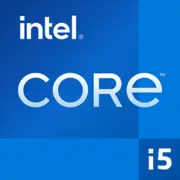Intel Core i5-12600H

Intel Core i5-12600H: Hybrid Power for Versatile Laptops
March 2025
Architecture and Process Technology: Hybrid Cores and the Evolution of Intel 7
The Intel Core i5-12600H processor, released in 2022, became part of the revolutionary Alder Lake generation. This architecture introduced a hybrid architecture for the first time, combining P-cores (Performance) and E-cores (Efficiency). The chip features 4 performance cores (operating at up to 4.5 GHz in turbo mode) and 8 energy-efficient cores, resulting in a total of 12 cores and 16 threads. This approach allows a balance between speed and battery life: P-cores handle heavy tasks (rendering, gaming), while E-cores manage background processes.
The Intel 7 process technology (formerly known as 10nm Enhanced SuperFin) ensures a high transistor density and improved energy efficiency. The integrated graphics Intel Iris Xe (80 EU) supports 4K displays and light gaming on low settings (for example, CS:GO at 60 FPS). However, discrete graphics are required for AAA games.
Power Consumption and TDP: Balancing Power and Mobility
The nominal TDP of the processor is 45 W, but in reality, it ranges from 35 W to 95 W in turbo mode. This makes it ideal for thin gaming laptops and workstations. In comparison, AMD Ryzen 5 series 6000H processors (for example, the 6600H) offer 6 cores at a similar TDP but lack a hybrid architecture.
Energy-Saving Technologies:
- Intel Dynamic Tuning 2.0 — automatically adjusts power based on load.
- Speed Shift Technology — instantly changes frequencies to reduce latency.
- Task Distribution Between Cores — background applications (messengers, updates) run on E-cores, conserving battery life.
Performance: From Office to Gaming
Geekbench 6:
- Single-Core: 2048 (comparable to Apple M1 Pro, which scores ~2100).
- Multi-Core: 9090 (higher than the Ryzen 5 6600H, which scores ~8000).
Real-World Scenarios:
- Office Work: Running dozens of tabs in Chrome, Word, Excel, and Zoom — without lag.
- Multimedia: Rendering 1080p video in Premiere Pro takes ~25 minutes (versus ~35 for the i5-11600H).
- Gaming: Paired with an NVIDIA RTX 3050 Ti — Cyberpunk 2077 on medium settings (45-50 FPS), Fortnite on ultra (90 FPS).
- Turbo Mode: Under load, the frequency of P-cores reaches 4.5 GHz, but duration depends on cooling. In ultrabooks (like the Asus ZenBook Pro 14), turbo lasts 2-3 minutes, in gaming models (MSI Katana GF66) — up to 10 minutes.
Use Cases: Who is the i5-12600H Suitable For?
1. Students and Office Workers: Multitasking + 8-10 hours of battery life in light modes.
2. Creative Professionals: Fast rendering in Photoshop, Lightroom, Blender.
3. Casual Gamers: For gaming at medium settings in Full HD.
4. Engineers and Developers: Code compilation, working with virtual machines.
Not Suitable For:
- Hardcore gamers requiring 4K/120 FPS.
- Users for whom battery life exceeding 12 hours is critical (better to look at Apple M-series).
Battery Life: How Long Will the Battery Last?
With laptops having a capacity of 60-70 Wh (for example, Dell XPS 15):
- Web surfing: 7-8 hours (brightness at 150 nits).
- Video playback: 6 hours.
- Load (rendering): 2-2.5 hours.
Influencing Factors:
- High-resolution screens (4K) reduce runtime by 20-30%.
- The “Power Saving” mode extends battery life by 1-2 hours.
- The Intel Adaptix Dynamic Tuning technology learns user habits, optimizing power consumption.
Comparison with Competitors
1. AMD Ryzen 5 6600H (Zen 3+):
- 6 cores / 12 threads, TDP 45 W.
- Better integrated graphics with Radeon 660M (comparable to GTX 1650 Mobile).
- $100 cheaper, but underperforms in multithreaded tasks (9090 vs 8000 in Geekbench 6).
2. Apple M1 Pro:
- 10 cores (8 Performance + 2 Efficiency), 16 GB RAM by default.
- Battery life up to 18 hours, but limited compatibility with Windows software.
- Higher price ($1800+ versus $1000-1300 for laptops with i5-12600H).
3. Intel Core i7-11800H (Tiger Lake generation):
- 8 cores / 16 threads, TDP 45 W.
- Lags behind the i5-12600H by 15-20% in multithreaded tasks due to lack of E-cores.
Pros and Cons
Strengths:
- High multithreaded performance for its price.
- Support for DDR5 and PCIe 4.0 (relevant in 2025).
- Hybrid architecture for a balance of speed and battery life.
Drawbacks:
- Heating in turbo mode (up to 95°C in compact cases).
- Integrated graphics weaker than AMD Radeon 660M.
- Requires a good cooling system.
Laptop Selection Recommendations
1. Type of Device:
- Ultrabook: ASUS ZenBook 14X (price from $1100) — weight 1.4 kg, OLED 2.8K display.
- Gaming Laptop: Lenovo Legion 5 (from $1300) — RTX 3060, 165 Hz display.
- Workstation: HP ZBook Firefly 15 G9 (from $1500) — ECC RAM support, ISV certification.
2. What to Pay Attention To:
- Cooling: At least 2 fans + heat pipes.
- Battery: From 70 Wh for 6+ hours of battery life.
- Display: For creative tasks — 100% sRGB, for gaming — 144 Hz+.
Final Conclusion
In 2025, the Intel Core i5-12600H remains a cost-effective choice for those seeking a versatile laptop for $1000-1400. It is well-suited for:
- Students — for studying and light gaming.
- Freelancers — working with graphics and video editing.
- Office Users — multitasking without lag.
Key Benefits: The power of hybrid cores, compatibility with modern hardware (DDR5, PCIe 4.0), and an optimal price-performance ratio. If battery life and low thermal output are priorities, consider the Apple M2 or AMD Ryzen 7 7840U.
Basic
CPU Specifications
Memory Specifications
GPU Specifications
Miscellaneous
Benchmarks
Compared to Other CPU
Related CPU Comparisons
Share in social media
Or Link To Us
<a href="https://cputronic.com/cpu/intel-core-i5-12600h" target="_blank">Intel Core i5-12600H</a>

